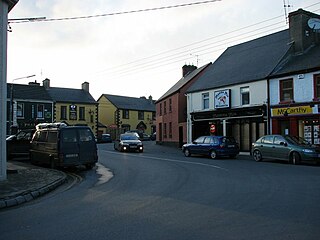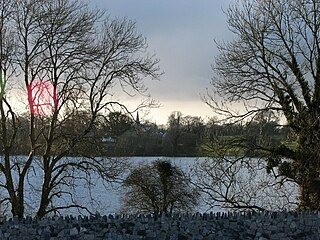
Shannon or Shannon Town, named after the river near which it stands, is a town in County Clare, Ireland. It was given town status on 1 January 1982. The town is located just off the N19 road, a spur of the N18/M18 road between Limerick and Ennis. It is the location of Shannon Airport, an international airport serving the Clare/Limerick region in the west of Ireland.

Newmarket-on-Fergus, historically known as Corracatlin, is a town in County Clare, Ireland. It is 13 kilometres from Ennis, 8 kilometres from Shannon Airport, and 24 kilometres from Limerick.

Corofin is a village on the River Fergus in northern County Clare, Ireland and also a parish of the same name in the Catholic Diocese of Killaloe.

Doora is a civil parish and village in County Clare, Ireland, just to the east of the town of Ennis. It is part of the Catholic parish of Doora Barefield. Parts of Doora are contained in the town of Ennis.

The name McInerney is of noble Irish origin where it is found in the modern Irish form of Mac an Airchinnigh and in the old and literary forms of Mac an Oirchinnigh and Mac an Oirchindig. The pronunciation of Mac an Oirchinnigh led the name to be sometimes anglicised as McEnherheny in Irish documents from the 16th–19th centuries. The name translates to "son of the erenagh" in Irish, literally meaning "son of the Lord of church lands". Airchinneach may in turn derive from the twin components of air ("noble") and ceann ("head"), therefore meaning a 'noble-head' or 'Lord', denoting its aristocratic status in medieval Ireland. The coat of arms is three red lions passant, and the motto is Veritas, meaning "Truth". In some places, the motto can be found as Vincit Veritas, meaning "Truth Conquers", or "Truth Prevails".

Bunratty is a village and civil parish in County Clare, Ireland. Bunratty Castle is located near the village. The village is accessed by the N18 connecting it to Limerick and to Galway. The Raite river defines the eastern boundary of the parish, and flows into the Shannon Estuary, which defines the southern boundary.

Sixmilebridge, best known as The Bridge, is a large village in County Clare, Ireland. Located midway between Ennis and Limerick city, the village is a short distance away from the main N18 road.

Kilnasoolagh is a civil parish in County Clare, Ireland, and a townland within that parish. Church records mention the parish in 1256.
Luchtigern was an early Christian leader who was active in Ireland in the 6th century, and has been recognized as a saint by the Catholic Church.
Tomfinlough is a civil parish in County Clare, Ireland. A Christian establishment was first made here around 540 AD. The parish lands were often raided by Irish, Viking, Norman and English forces in the years that followed. The church was allowed to fall into ruins during the period when the Catholic Church was penalized in Ireland.
Clonloghan is a civil parish of County Clare, Ireland, located 21.7 kilometres (13.5 mi) by road northwest of Limerick, just north of Shannon.
Bunratty Lower is a barony located in County Clare, Ireland. This ancient unit of land division is in turn divided into fourteen civil parishes.
Drumline is a civil parish of County Clare, Ireland, located about 20 kilometres (12 mi) northwest of Limerick, just north of Shannon.

Doonbeg (Killard) is a civil parish on the Atlantic coast of County Clare in Ireland. It is also an ecclesiastical parish in the Roman Catholic Diocese of Killaloe. The largest population centre in the parish is the village of Doonbeg.
Kilraghtis is a civil parish of County Clare, Ireland. It covers an area northeast of the town of Ennis, and includes the Ennis suburb of Roslevan.

Dysart and Ruan is a Catholic parish in County Clare, Ireland. It covers the civil parishes of Ruan and Dysert, and includes the village of Ruan, which holds the parish office. The parish contains the ruins of the 12th century St. Tola's Church, part of Dysert O'Dea Monastery.

Kilkeedy is a parish in County Clare and part of the Roman Catholic Diocese of Killaloe. The parish is the only parish in said diocese whose boundaries are still identical compared with the medieval situation.

Kilmaleery is a civil parish in County Clare, Ireland. It is part of the Catholic parish of Newmarket-on-Fergus.
Shannon, officially - but largely unused - St. Senan's Parish, is a parish in County Clare and part of the Tradaree grouping of parishes within the Roman Catholic Diocese of Killaloe. It is a split off of the parish of Newmarket-on-Fergus

Ballynacally-Lissycasey is a parish in County Clare and part of the Radharc na n-Oiléan grouping of parishes within the Roman Catholic Diocese of Killaloe.













